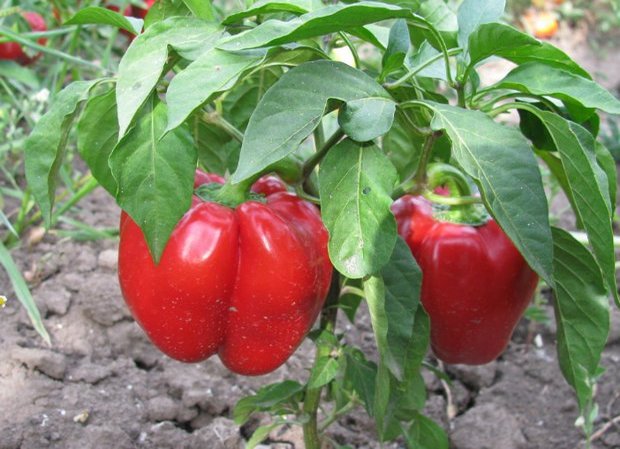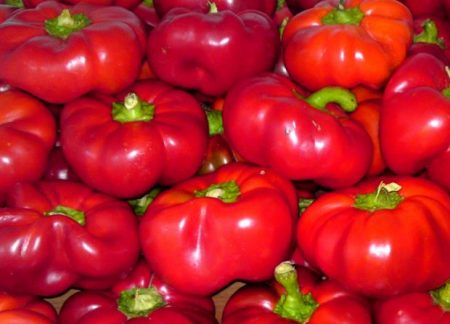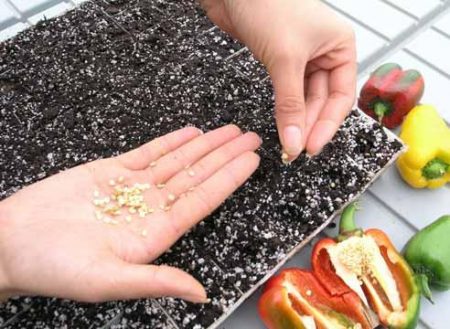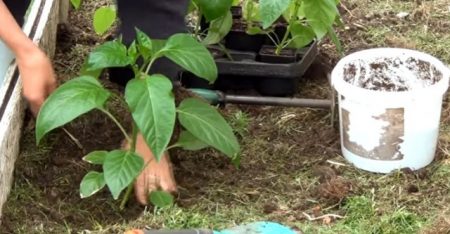 The Gogoshary variety, bred by Romanian breeders, has firmly established itself in the southern regions and temperate latitudes of our country. He fell in love with many for his high productivity, unpretentiousness and great taste.
The Gogoshary variety, bred by Romanian breeders, has firmly established itself in the southern regions and temperate latitudes of our country. He fell in love with many for his high productivity, unpretentiousness and great taste.
Content
Description of Gogoshary variety
The fruits of this variety have a flattened and ribbed shape resembling a pumpkin, tomato or squash. At the ripening stage, the pepper has a dark green color, and upon reaching ripeness it has a red or yellow color and a piquant sweet-spicy taste with a honey note. The fruits are quite juicy and fleshy, and the wall thickness can reach 8 mm. The average weight of the fruits is 90 - 140 g.
The culture refers to mid-ripening and late-ripening sweet pepper varieties: it gives a crop 100 days after the pollination process. Gogoshary pepper is represented by strong bushes 50-100 cm high with a dark trunk color and large dark green leaves of a rounded shape or oblong shape.
A characteristic feature of the variety Gogoshary is the ability to pollinate with nearby growing varieties of bitter pepper. Outwardly tied in this way, the fruits will be the same, but they will turn out to be sharp in taste. Therefore, near this variety is not recommended to cultivate hot peppers.
Fruits, if necessary, can be removed from the bushes unripe and left in a dry, warm place for 2 weeks.

Variety ripening begins in mid-July. From each bush you can collect 3 - 3.5 kg of aromatic fruits.
Sowing seeds
Seedlings of this variety are planted in open ground in May, so you need to prepare for the sowing of seeds in advance and make the following preparations:
- For nutritious soil you need to connect peat, humus and sod in a ratio of 2: 1: 2. You can add a little bit of sawdust and sand to the mixture.
- Hold the seeds for half an hour in a weak solution of potassium permanganate and rinse with warm water.
- Wrap disinfected seeds in wet gauze for 2 to 3 days for germination. Make sure that the fabric does not dry completely and moisten it periodically.
- Place the soil in prepared containers, moisten it and carefully place the sprouted seeds. Sprinkle 1 cm of soil on top, cover the containers with transparent material (glass or film) and place in a sunny, warm place with a temperature of 24 - 26 ° C. According to the experience of vegetable growers, containers with hatched seedlings are not recommended to be moved or relocated to another place.
- After the appearance of the first sprouts, the transparent material is removed.
It should be borne in mind that Gogoshara pepper is extremely demanding on heat. When growing seedlings, it is necessary to maintain the temperature regime around the clock. With a decrease in temperature of at least 2 or 3 degrees, the growth of seedlings can slow down significantly.

Picking seedlings
Although Gogoshary is very sensitive to transplanting, it is still necessary, since this process provides an incentive for the growth of healthy fruits and the formation of a strong root system.
When forming two leaves, they begin to pickle seedlings. In the tank, previously washed with a solution of potassium permanganate, soil is poured, the composition of which is identical for sowing seeds. Gently take the sprout with your fingers and pry the spine with a spoon. The sprout is placed in a new container, but not deeply buried in the soil. Sprinkle with soil and lightly crush.Pour water at room temperature and expose to a sunny room without drafts with a maintained air temperature of about 25 ° C.
Planting seedlings on beds and care
Under the southern sun, seedlings can be planted on beds in May. When planting pepper, you should strive to place it away from other varieties of pepper, especially bitter. It is desirable that the beds with pepper are well lit by the sun and are on a certain height.
After planting in open ground, seedlings should be watered.
Further care for the pepper is very simple: maintaining a temperature of 25 ° C and the necessary humidity. The culture is watered sparingly and always with room temperature water. As for loosening, many summer residents do not advise doing this, but it is better to mulch the bush with husk, humus or straw 10 cm high. Fertilizing is carried out with nitrogen, phosphorus or potassium fertilizers in the case of “poor” soil: nitrogen fertilizing is carried out for the plant's strength, during flowering - phosphoric, and to obtain beautiful fruits - potash. Although culture does not like pinching, it is necessary to do this - an abundance of ovaries will affect the quality and size of the fruit.

How to harvest
The first crop is harvested when the fruits reach technical maturity. They are cut off with the peduncle and allowed to reach in a dark, dry and warm room. This technique will allow you to get the next wave of the crop more abundant.
Reviews
All summer residents unanimously claim that the Gogoshary variety is the most fleshy and thick-walled pepper, which is ideal for stuffing and making your favorite lecho.




 Calorie pepper stuffed with meat and rice - BZHU per 100 grams
Calorie pepper stuffed with meat and rice - BZHU per 100 grams Gorky pepper - the best varieties for open ground
Gorky pepper - the best varieties for open ground Hot pepper seeds - the best varieties for open ground and reviews
Hot pepper seeds - the best varieties for open ground and reviews Capsicum tincture for hair - how to use and reviews
Capsicum tincture for hair - how to use and reviews